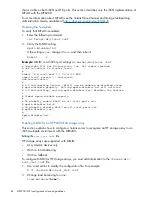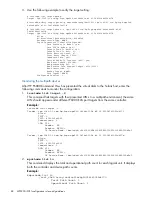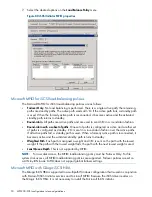
3.
Change auto-failback to
disable
:
auto-failback="disable";
4.
Add the following lines for the EVA4x00/6x00/8x00 storage arrays:
device-type-scsi-options-list =
“HP HSV“, “symmetric-option“;
symmetric-option = 0x1000000;
NOTE:
You must enter six spaces between
HP
and
HSV
.
Example:
HP storage array settings in
/kernel/drv/scsi_vhci.conf
#
# Copyright 2004 Sun Microsystems, Inc. All rights reserved.
# Use is subject to license terms.
#
#pragma ident "@(#)scsi_vhci.conf 1.9 04/08/26 SMI"
#
name="scsi_vhci" class="root";
#
# Load balancing global configuration: setting load-balance="none" will cause
# all I/O to a given device (which supports multipath I/O) to occur via one
# path. Setting load-balance="round-robin" will cause each path to the device
# to be used in turn.
#
load-balance="none";
#
# Automatic failback configuration
# possible values are auto-failback="enable" or auto-failback="disable"
auto-failback="disable";
#
# For enabling MPxIO support for 3rd party symmetric device need an
# entry similar to following in this file. Just replace the "SUN SENA"
# part with the Vendor ID/Product ID for the device, exactly as reported by
# Inquiry cmd.
#
# device-type-scsi-options-list =
# "SUN SENA", "symmetric-option";
#
# symmetric-option = 0x1000000;
#
device-type-scsi-options-list =
"HP HSV","symmetric-option";
symmetric-option = 0x1000000;
5.
Reboot to activate the changes:
# reboot -- -r
Editing the
sgen.conf
file
To ensure that the HP storage arrays are recognized by Solaris as SCSI controllers, you must add
information to the
/kernel/drv/sgen.conf
file:
1.
Use a text editor to modify the configuration file. For example:
# vi /kernel/drv/sgen.conf
2.
Add
array_ctrl
to
device-type-config-list
:
device-type-config-list="array_ctrl"
;
3.
Uncomment all target/LUN pair entries.
Example:
HP storage array settings in
/kernel/drv/sgen.conf
.
.
.
# devices on your system. Please refer to sgen(7d) for details.
Setting up the iSCSI initiator
85






























